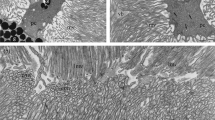Summary
The effects of diltiazem, a drug which inhibits the calcium channels in cardiac muscle as well as the light-sensitive channels in photoreceptor cells, were studied on ionic fluxes in both membrane and intact cell preparations. Diltiazem nonselectively increased the ionic permeability to both anions and cations in photoreceptor rod outer segment and synaptic membrane vesicles as well as in intact erythrocytes. Under our conditions, the estimated threshold for the diltiazem effect varied between 12.5 and 200 μm. In each case the concentration dependence exhibited the sigmoidal shape characteristic of positive cooperativity. The effect of diltiazem on ionic fluxes from phospholipid vesicles were strongly influenced by phospholipid composition and membrane charge. By contrast, diltiazem inhibited the efflux of86Rb from photoreceptor cells of intact aspartate-isolated retina, an effect opposite to that of diltiazem on ionic permeabilities in photoreceptor membrane vesicle preparations.
These data raise serious doubts on the specificity of diltiazem as a calcium channel blocker or as a cGMP channel blocker when used at concentrations higher than 10 μm.
Similar content being viewed by others
References
Booth, R.F.G., Clark, J.B. 1978. A rapid method for the preparation of relatively pure metabolically competent synaptosomes from rat brain.Biochem. J. 176:365–370
Bretscher, M.S. 1972. Phosphatidylethanolamine: Differential labeling in intact cells and cell ghosts of human erythrocytes by a membrane-impermeable reagent.J. Mol. Biol. 71:523–528
Capovilla, M., Caretta, A., Cervetto, L., Torre, V. 1983. Ionic movements through light sensitive channels of toad rods.J. Physiol. 343:295–310
Caretta, A., Cavaggioni, A. 1983. Fast ionic flux activated by cyclic GMP in the membrane of cattle rod outer segments.Eur. J. Biochem. 132:1–8
Caretta, A., Cavaggioni, A., Sorbi, R.T. 1979. cGMP and the permeability of the disk of the frog photoreceptors.J. Physiol. 295:171–178
Caretta, A., Cavaggioni, A., Sorbi, R.T. 1985. Binding stoichiometry of a fluorescent cGMP analogue to membranes of rod outer segments.Eur. J. Biochem. 153:49–53
Caretta, A., Saibil, H. 1989. Visualization of cyclic nucleotide binding sites in the vertebrate retina by fluorescence microscopy.J. Cell Biol. 108:1517–1522
Cavaggioni, A., Sorbi, R.T., Turini, S. 1972. Efflux of potassium from the isolated frog retina: A study of the photic effect.J. Physiol. 222:427–445
Cook, N.J., Hanke, W., Kaupp, U.B. 1987. Identification, purification and functional reconstitution of cyclic GMP dependent channel from rod photoreceptors.Proc. Natl. Acad. Sci. USA 84:585–589
Cook, N.J., Molday, L.L., Reid, D., Kaupp, U.B., Molday, R.S. 1989. The cGMP gated channel of bovine photoreceptors is localized exclusively in the plasma membrane.J. Biol. Chem. 264:6996–6999
Cook, N.J., Zeilinger, C., Koch, K.W., Kaupp, U.B. 1986. Solubilization and functional reconstitution of the cGMP-dependent channel from rod photoreceptors.J. Biol. Chem. 261:17033–17039
Fesenko, E.E., Kolesnikov, S.S., Lyubarsky, A.L. 1984. Induction by cGMP of cationic conductance in plasma membrane of retinal outer segments.Nature 313:310–313
Hirth, C., Borchard, U., Hafner, D. 1983. Effect of the calcium antagonist diltiazem on action potentials, slow response and force of contraction in different cardiac tissues.J. Mol. Cell. Cardiol. 15:799–809
Kamps, K.M.P., De Grip, W.J., Daemen, F.J.M. 1982. Use of a density modification technique for isolation of the plasma membrane of rod outer segments.687:296–302.
Koch, K.W., Kaupp, U.B. 1985. Cyclic GMP directly regulated a cationic conductance in membranes of bovine rods by a cooperative mechanism.J. Biol. Chem. 260:6788–6800
Molday, R.S., Molday, L.L. 1987. Differences in protein composition of bovine retinal rod outer segment disk and plasma membranes isolated by a ricin-gold-dextran density perturbation method.J. Cell Biol. 105:2589–2601
Op den Kamp, J.A.F. 1979. Lipid asymmetry in membranes.Annu. Rev. Biochem. 48:47–71
Pearce, L.B., Calhoon, R.D., Burns, P.R., Vincent, A., Goldin, S.M. 1988. Two functionally distinct forms of guanosine 3′-5′-phosphate stimulation cation channels in bovine rod photoreceptor disk preparation.Biochemistry 27:4396–4406
Rispoli, G., Menini, A. 1988. The blocking effect ofl-cis-diltiazem on the light sensitive current of isolated rods of the tiger salamander.Eur. Biophys. J. 16:65–71
Stern, J.K., Kaupp, U.B., MacLeish, P.R. 1986. Control of the light regulated current in rod photoreceptors by cyclic GMP, calcium andl-cis-diltiazem.Proc. Natl. Acad. Sci. USA 83:1163–1167
Author information
Authors and Affiliations
Rights and permissions
About this article
Cite this article
Caretta, A., Sorbi, R.T., Stein, P.J. et al. Diltiazem at high concentration increases the ionic permeability of biological membranes. J. Membrain Biol. 122, 203–213 (1991). https://doi.org/10.1007/BF01871421
Received:
Revised:
Issue Date:
DOI: https://doi.org/10.1007/BF01871421




